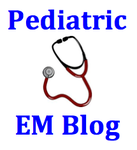|
Hey everyone, This year the PEM fellows have decided to do PEM Journal club a little differently from last year. Periodically we will critically appraise the evidence behind the clinical protocols that we currently use in our Pediatric ED to better understand why we do what we do. For our first protocol, we reviewed the new Peds ED Asthma Pathway. Below are the take home points for the main topics that we discussed. Enjoy! - Kat Bryant Dexamethasone vs Prednisolone:
0 Comments
Your comment will be posted after it is approved.
Leave a Reply. |
Pediatric EM BlogAuthorPediatric EM Fellows at CMC/Levine Children's Hospital. Archives
November 2016
Categories
All
Disclaimer: All images are the sole property of CMC Emergency Medicine Residency and cannot be reproduced without written consent. Patient identifiers have been redacted/changed or patient consent has been obtained. Information contained in this blog is the opinion of the authors and application of material contained in this blog is at the discretion of the practitioner to verify for accuracy.
|

 RSS Feed
RSS Feed
